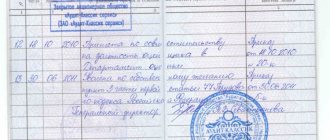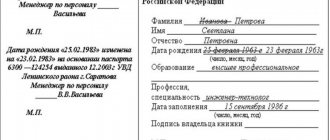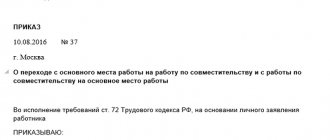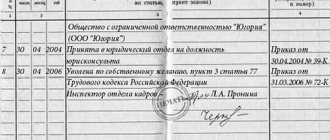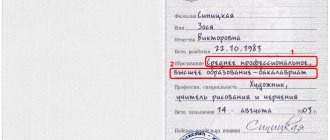A work book is the main document reflecting a person’s work activity throughout his life.
It is by taking into account the data entered in the work book that the length of service is calculated, allowing one to use the opportunity to retire when working in harmful or dangerous working conditions, and a pension is assigned and accrued, both by age and by preferential length of service.
When applying for a pension, if any incorrect information is found in the work book:
- indication of a person’s personal data;
- dates of hiring and dismissal;
- reasons for dismissal;
- indication of the numbers and dates of issue of the orders on the basis of which the entries were made,
Difficulties arise with the assignment of pension payments and, in general, the right to receive a certain type of pension.
In addition, the possibility of finding a job in a new place sometimes depends on the record of dismissal from a previous place of work.
All people tend to make mistakes sometimes.
HR department employees, who are usually responsible for maintaining and recording the work books of enterprise employees, are also not robots; they can even make a purely mechanical mistake when filling out information.
There is nothing fatal in such situations.
Of course, you need to be very careful when making a new or next entry in the work book.
It is also necessary to check what was written again, so that if an error is made, it can be corrected immediately on the spot, and a person several years later, when new entries have already been made after an erroneous one, or the enterprise has been reorganized, liquidated, run through the courts, archives, and restore past events years to make corrections.
The employee is informed of all changes made to the work book, given personal signature in a personal card in a certain T-2 form, which is also maintained in parallel with the work book by the responsible employee of the personnel department or other official of the organization appointed by order.
Therefore, the employee himself should not automatically sign the entry that he is familiar with the changes made to the work book, but read them carefully.
So, if the date of dismissal is incorrectly indicated in the work book, this may become an obstacle when applying for a job in another organization, since it will take some time to make corrections.
A vacant position may not always remain vacant as long as a person is busy trying to get the former employer to correctly record the date of dismissal.
Ultimately, you may lose your chance to get a new position.
For example, in fact, an employee quits the company on 10/01/2016, and the entry in the work book about the dismissal is 11/01/2016.
It would seem that this is a purely automatic typo, however, if on October 28, 2016 a person wants to get a job, it will look more than ridiculous to have an entry in the work book after being fired from the previous company in November and being hired by a new company in October of the same 2021.
It is necessary to make changes to the work book to invalidate the previous entry and indicate the correct date of dismissal.
Rules:
- how to keep records in a work book;
- when and how to make changes, corrections,
specified in:
- Instructions for filling out work books, developed and approved in 2003 by Resolution No. 69 of October 10 of the Ministry of Labor and Social Development of the Russian Federation of October 10, 2003. No. 69 (Instructions);
- and the Rules for maintaining and storing work books (Rules), which were also approved in 2003 by government decree of April 16 no. No. 225.
What claim can an employee challenging his dismissal bring to court?
An employee may file a claim in court:
- on recognizing the dismissal as illegal and changing the wording of the reason for dismissal;
- for reinstatement to his previous position.
In the first case, the court makes a decision not to reinstate the employee, but to change the wording of the grounds and reasons for dismissal.
In his decision, he will indicate the basis and reason for dismissal in strict accordance with the wording of the Labor Code or other federal law.
More on the topic:
Dismissal - digest
Expert explanation on the procedure for correcting an erroneous dismissal date in the work book
The information portal of Rostrud “Onlineinspektsiya.RF”, September 2015, reports the following on this part of the issue. If incorrect (inaccurate) information is discovered, corrections must be made in the organization where this information was recorded. It is allowed to correct erroneous entries at a new place of work if there is a reason - an identification document from the organization where the error was made. Rostruda draws attention to the fact that the employer is obliged to provide the employee who contacts him with comprehensive assistance in resolving this issue.
Changes are made through declaring the erroneous entry invalid ( clause 30 of section 3 of the Rules ). The changes made must correspond to the original data of the document on the basis of which they were made . If the “source” is lost or contains some discrepancies, changes can be made on the basis of other documents that certify the necessary facts regarding the work performed.
Example 1. Mistake in the date of dismissal: procedure for correction
E. T. Gribova actually quits on February 15, 2018. The basis is the order of the employer No. 5 dated February 14, 2018. When making an entry for dismissal No. 6 in the employee’s work book, the personnel employee made a typo and wrote “12/15/2018” instead of this date.
In this case, only the date of dismissal needs to be adjusted. The adjustment procedure requires recognizing the distorted entry as invalid and indicating the exact date of dismissal. In the work book, the personnel employee makes the following entries for this purpose, verbatim:
- Column “1”: “No. 7”.
- Column “2”: “02/15/2018”.
- Column “3”: “The entry for No. 6 is considered invalid. Dismissed on February 15, 2021 at her own request, clause 3 of Art. 77 Labor Code of the Russian Federation."
- Column “4”: “Order No. 5 of February 14, 2018.”
Next, the personnel employee writes down his position, signs, and stamps.
If the employee brought a court decision, issue an order
If the court decides to change the grounds or date of dismissal of the employee, the employer should issue a corresponding order and make an appropriate entry about this in the employee’s work book.
An order issued by an employer in pursuance of a court decision must:
- or cancel the previous order and set a new date (grounds) for dismissal;
- or make appropriate changes to the previous order.
In this case, reference should be made to the court decision as the basis for issuing a new order.
The order to cancel or change the initial order of dismissal of the employee must be read and signed.
If he refuses to sign, it is necessary to draw up an appropriate act about this.
If an employee has been reinstated to his previous position by a court decision, the employer does not need to issue an order for reinstatement.
The meaning of the reinstatement procedure is precisely to cancel the legal consequences of dismissal by canceling the dismissal order.
The Supreme Court came to this conclusion in its ruling dated April 23, 2010 No. 5-B09-159.
We also note that an integral part of the process of reinstatement at work is the employer’s obligation to pay wages during forced absence.
It occurs simultaneously with the cancellation of the dismissal order and the restoration of the employee to his previous position (Decision of the Supreme Court dated April 23, 2010 No. 5-B09-159).
Previously on the topic:
How to reinstate an employee?
Full employee reinstatement
Correcting entries in the work book after dismissal
However, often the presence of an error in the date of dismissal becomes known after the employee ceases to work for the inattentive employer. An employee does not always notice an incorrect entry in a timely manner, or documents are sent to him by mail, preventing him from reporting the error in time.
If you discover an inaccuracy after dismissal, you should contact the personnel department or the official responsible for maintaining work records with a request to correct it. The request is stated in a statement addressed to the director of the company. If necessary, the manager issues an order to make changes, the details of which are then entered in column 4. The personnel officer corrects the incorrect entry in the above order. At the same time, he again enters the details of the initial dismissal order (if the correct date is indicated in it), or indicates a new order that corrects the error in the previous order.
If the company that made the mistake no longer exists, its legal successor or the last employer of the book owner has the right to correct the date of dismissal. However, he will do this only if he has documentary evidence of the date distortion. The employee is obliged to provide him with:
- or a certified copy of the dismissal order, which he stocked up on in advance;
- or an archival certificate confirming his words.
Witness testimony is taken into account only in cases where there has been a massive loss of work records (for example, in connection with a natural disaster) or in relation to records on which a court decision has been made (clause. Rules for maintaining work records).
How are entries made in the work book if the dismissal was challenged in court?
An entry in the work book about a change in the date or wording of the reason for dismissal is made if the work book is with the employer at the time the resolution of the labor dispute is completed or if the employee, who previously received the work book upon dismissal, provides it to the employer for making an entry.
The work book must:
- record the invalidity of the original dismissal record;
- and make the correct entry. For example: “The entry for number so-and-so is invalid, dismissed (a new date or wording of the reason is indicated).”
In this case, the basis for recording changes in the wording of the reason or date of dismissal will be an order of the employer or a corresponding court decision.
In addition, upon a written application from the employee, he must be issued a duplicate work book without making an entry in it that has been declared invalid.
Rostrud drew attention to this in a report on the prevention of violations in the field of labor legislation for the third quarter of 2020.
More on the topic:
Who will correct mistakes in a new employee’s work record?
How to correct errors in a work book
Incorrect entry in the work book upon dismissal
The easiest way to correct an incorrect dismissal date is if an error was made at the last place of work from which the citizen left. This usually happens due to the inattention or insufficient qualifications of a personnel specialist. For example, when the date, month or year is incorrectly indicated. It also happens that an employee, at the initiative of management, is fired during vacation or illness, which is not allowed by the Labor Code (81st Article of the Labor Code of the Russian Federation), except in the case of liquidation of the company - such a dismissal date is also incorrect.
Having noticed an error in the date of dismissal, the employee must bring it to the attention of the personnel service and ask it to be corrected. Before this is done, he should not sign a document stating that he agrees with all the entries made in the work book. Otherwise, you will have to act according to a more complex scheme.
Correction of the dismissal entry in the work book is carried out in the following order:
- in column 1 the next serial number of the entry is entered (the numbering sequence should not be violated);
- Column 2 records the date of changes;
- in column 3 it is first written that the entry under a certain number is invalid, followed by the correct, corrected text;
- Column 4 indicates the basis for changing the entry (usually the details of the original or newly issued order that made the changes, or a court decision are written here).
Detailed information on the procedure for correcting entries in work books is contained in the Instructions for filling them out (Resolution of the Ministry of Labor of the Russian Federation No. 69 of October 10, 2003). Section 3 of the Rules for Maintaining Labor Records (Resolution of the Government of the Russian Federation No. 225 of April 16, 2003) is also devoted to this issue.
Examples of correcting errors in a work book: important rules and actions
Sometimes the information reflected in the TC must be subject to changes. Sometimes an employee’s passport details, degree of education, and profession change. In addition, personnel officers sometimes make mistakes themselves when filling out the document. Let's figure out what to do in such situations.
What to do if you made a mistake when filling out the work form?
If an incorrect entry or information that does not correspond to reality is found in an employment document, it must be corrected where the inaccurate entry was created, or at a new workplace, be sure to have an official document from the employer who made the inaccuracy.
If a company disappears where a mistake was made when filling out the Labor Code, the corrective entry must be entered in the new workplace. When there is no such company, the enterprise where the employee currently works should be responsible for correcting the information in the Labor Code. The basis for creating corrections should be extracts from the necessary archival documents.
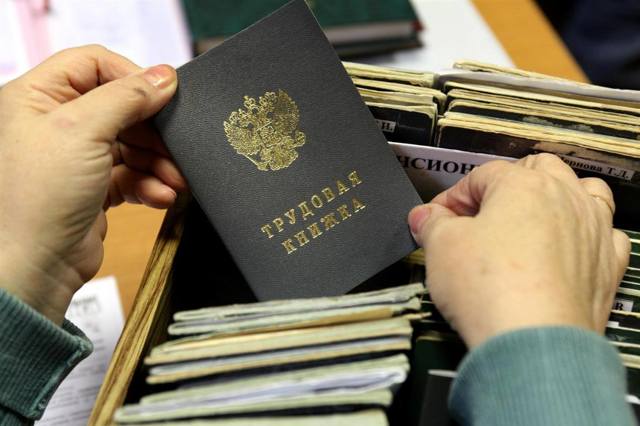
Making changes to the work book when an error is made.
As has already become clear, changes to the Labor Code can be made if inaccurate information is discovered. This also arises in cases of changes in personal information about the worker, information about his profession, or degree of education.
To change an entry, you should follow the procedure. After the most recent entry in the book, it is necessary to enter the entry number in the first column in order, in the second column to record the date the entry was changed, and then in column 3 to display information about the reflection of the incorrectness or inaccuracy of the previous entry.
A valid entry is then written. In this case, in the fourth column it is necessary to indicate the name of the document, on the basis of which the correct entry is reflected in the TC.
A similar procedure applies to many situations regarding the invalidation of information about:
- Transfer to a new position on a permanent basis.
- Dismissal.
- Unlawful dismissal.
All information is entered on the basis of issued orders from the employer.
This information can be entered no later than a week from the date the order is issued. The exception here would be dismissal - this entry must be written on the day of dismissal.
The records must comply with the orders according to which they were registered in the employee’s Labor Code.
Abbreviations in the Labor Code at the time of reflecting new information are prohibited. Corrections are made exclusively in Russian.
There are exceptions - a work book may contain information recorded in two languages, and the second may be the language of the republic that is part of the Russian Federation and has established its own state language.
There are no special rules for maintaining a work book in a second language, but it seems that information in this format should be entered immediately after the first one, which was written in Russian.
The employer must inform the employee of any changes made to the Labor Code. The guarantee of familiarization will also be the personal signature of the employee in a special card in form No. T-2. This entry must be duplicated there.
Actions for specific errors
The procedure for changing incorrect information in a work book is generally standard for most situations, but there are cases in which there are nuances in registering changes in the work book. There are no fundamental differences from the basic situation, but it is necessary to strictly adhere to the order that was assigned by law for each specific situation.
Incorrect date

Correction of the record must occur according to the rules.
If the date of an event that occurred is incorrectly reflected - hiring, dismissal - HR specialists have two options for the development of events on how to make a change.
The first option is to make a note about the invalidity of the information under a certain serial number and immediately need to write down the correct date right there. The second option is to enter information twice: in the first entry indicate the incorrect data, and in the second indicate the correct date.
Both options have the same result, therefore. Each personnel officer chooses here the option that is more convenient for him.
Eg:
| 7 | 08.10.2014 | Open Joint Stock Company "Territory" Recruited to the investigative department as an assistant. |
How to correct the date in the work book?
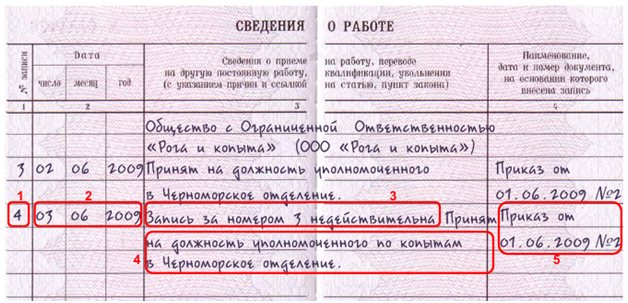
A work book is a document necessary for each employee, in which all the facts about his work activity are recorded. It will be useful for calculating the insurance period when applying for pension payments. Like other official documents, the book requires accurate and careful filling out.
However, many employers often make mistakes that can cause serious consequences for both themselves and their subordinates. For example, the date of birth of the owner of the document may be incorrectly indicated or the reason for his dismissal may be incorrectly determined.
How to correct the date in a work book? What actions need to be taken and what documents should I provide? Read about this in this article. In addition, we will tell you what the employer faces for errors in working with labor documents, as well as how to avoid such inaccuracies in the future.
How to make changes?
Adjustments can be made by both the head of the organization and an authorized person - a personnel department employee, chief accountant or secretary. The procedure for making corrections to work books is established by Decree of the Government of the Russian Federation No. 225 . So, in order to correct the date, you must adhere to the following rules:
- Changes are made by employees of the same organization that made the mistake;
- You cannot cross out, erase or correct entries;
- All new entries must be supported by relevant documents;


